Army Says It Needs $2B More Per Year For Big Six: Over Half For Air & Missile Defense
Posted on
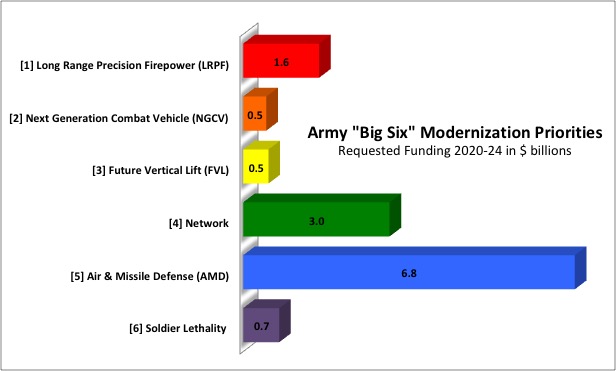
UPDATED with expert comment WASHINGTON: The Army needs “an additional $2-3 billion per year,” above its already generous 2019 budget, to fund its Big Six modernization priorities in the 2020s, says a new strategy document submitted to Congress. All told, the Army plans to spend over $13 billion on the Big Six over the five years from 2020 to 2024.
More than half of that money, $6.8 billion, goes to air and missile defense, ostensibly only the fifth of the six priorities. Not quite a quarter, $3 billion, goes to the No. 4 priority: Army command, control, and communications networks, including alternatives to GPS. By contrast, the top three priorities — long-range artillery and missiles, armored vehicles, and aircraft — get less than 20 percent combined, $2.6 billion.
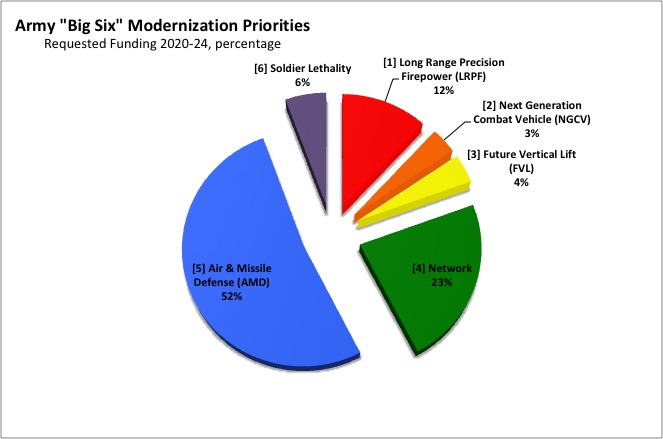
The Army’s repeatedly emphasized that the Big Six are in order of importance, so why is it spending more on lower priorities than on higher ones? The document doesn’t say. But looking at the specific initiatives listed under each priority, it’s clear that air & missile defense and the network have more programs ready to go into production. The other areas are still focused on relatively inexpensive R&D, which often fails to translate into a funded procurement program.
The Army’s current leadership might emphasize a particular set of priorities, but what weapons are actually developed and ready to buy depends on their predecessors’ choices years ago. While there’s a big push across the Pentagon for acquisition reform, centered on a new Army Futures Command, the long timelines and institutional inertia of major programs mean that it will take years for the full impact of today’s decisions to be felt.

Mid-Tier Priorities Get Top Dollar
For example, the most expensive single initiative — part of the Air & Missile Defense portfolio — is $3.2 billion for Maneuver Short-Range Air Defense, the Army’s crash program to rebuild the frontline anti-aircraft units it largely disbanded after the Cold War. Identified as an urgent need in the face of Russian aggression, the M-SHORAD was already underway before Army Chief of Staff Mark Milley identified the Big Six. The program also relies on putting proven missiles and radars on a proven platform, the 8×8 Stryker, rather than inventing any new technology, so it can move quickly into production.
The second most expensive line item, also under Air & Missile Defense, is $2 billion for the Integrated Air & Missile Defense Command System. IBCS is meant to share targeting data among Patriot, THAAD, future anti-missile systems like lasers, and an array of Army radars. IBCS was the Air & Missile Defense community’s top priority before the Big Six were named and was already underway well before M-SHORAD.

The third most expensive item falls under Priority No. 4, the Army command-and-control network: $1.65 billion for vaguely defined “network modernization.” Networks are another priority that long pre-dates the Big Six, but since Gen. Milley cut short the primary network program, WIN-T, you might have expected a delay here and a corresponding drop in funding. Why not? Probably because the Army has a host of lesser network initiatives to invest in, and because it plans to rely heavily on commercial technology, so it doesn’t have to spend time developing all the tech itself.

By contrast, a new generation of optionally manned and robotic ground and air vehicles — Next Generation Combat Vehicle and Future Vertical Lift — are still being prototyped:
The first FVL demonstrator is already in the air, and the Army wants to accelerate its entry into service ahead of the 2030s, but the timeline is uncertain — in part because the Army is now putting equal priority on a small, agile armed reconnaissance aircraft as on the larger troop carrier that FVL had prioritized.

Ground vehicle prototypes are supposed to be built by 2019 and will go through a rapid cycle of test, redesign, and test from 2020 to 2024, but even if all goes well, mass production would begin after this five-year budget plan.
BEGIN UPDATE Admittedly, if you also counted current programs for helicopters and armored vehicles, the numbers would be much higher.
“Much of the disconnect comes with how the Army has defined the Big Six,” said Andrew Hunter, a former Pentagon official now with the Center for Strategic & International Studies. “For combat vehicles, they only credit funding for next generation vehicles, because that’s how they defined that priority. But the Army is spending a ton of money this year and next on combat vehicle upgrades”: notably, new weapons, defenses, and automotive systems for the M1 Abrams main battle tank, M2 Bradley infantry fighting vehicle, the M109A7 Paladin howitzer, and the 8×8 Stryker infantry carrier.
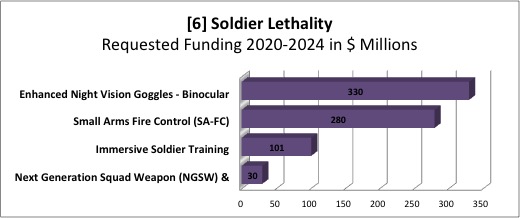
A CSIS study in fact recommended emphasizing these upgrade programs as a faster way to modernize then developing new design. So, Hunter said, “I think if you considered their entire modernization portfolio, you’d have a more balanced picture of how the Army is allocating its modernization dollars by priority.”
But Gen. Milley has made it clear he wants radical improvements, not just gradual upgrades. That’s a risky course that has led the Army onto the shoals before — witness the fabled Future Combat System — but the Chief of Staff thinks it’s necessary to stay ahead of rapidly advancing adversaries. In some areas, in fact, we’re struggling just to catch up. That’s especially true with long-range missiles and other artillery, where the US is, as then-Lt. Gen. H.R. McMaster put it, “outranged and outgunned.” UPDATE ENDS
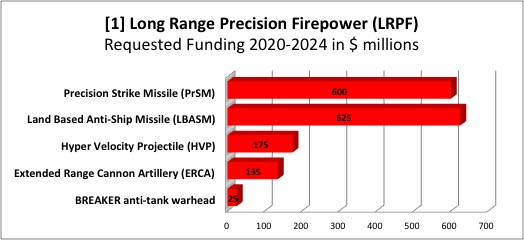
Priority #1: Long Range Precision Fires
The Army’s No. 1 Priority, Long Range Precision Fires (LRPF), is somewhere in the middle between “ready for mass production” and “still prototyping.
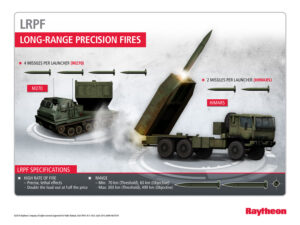
Raytheon’s proposal for the new Precision Strike Missile (PRSM), formerly the Long-Range Precision Fires (LRPF) weapon.
The Army had already begun a program to replace its aging ATACMS missiles with a lighter but longer-range Precision Strike Missile (PRSM, which confusingly used to be called LRPF). That program gets $600 million in this plan and would start fielding a basic “Increment 1” version in 2022-2023. That would be followed by upgrades to strike moving targets such as ships, part of a separate $625 million line item for a Land-Based Anti-Ship Missile (LBASM). PRSM would range up to 300 miles — potentially more if the US withdrew from the Intermediate Nuclear Forces treaty in response to Russian violations. It would be fired by existing launchers: the wheeled HIMARS, which the Army plans to buy 56 more of, and the tracked MLRS, where the plan is to refurbish 160 existing vehicles.
The Army also had a preexisting Extended Range Cannon Artillery program to enhance its howitzers. ERCA is funded at $135 million over 2020-2024 because even a dramatic upgrade to conventional artillery is cheaper than developing precision missiles.
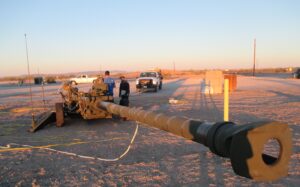
An Army M777 howitzer modified with an extra-long barrel for an Extended Range Cannon Artillery (ERCA) test.
On the other hand, the top effort under Long Range Precision Fires — the No. 1 priority of the No. 1 priority — is for an all-new Strategic Fires weapon with even longer range than PRSM. Strategic Fires would strike targets 300 to 1,400 miles (500 to 2,250 kilometers) away, potentially threatening Moscow from launch sites in Europe. That range in a land-based missile would violate the INF treaty, assuming the US doesn’t withdraw from it, but the Army is also looking at ultra-long-range cannon like the Super Guns developed by the late Gerald Bull. That the Army’s looking at such a wide range of options indicates that Strategic Fires is in a very early conceptual stage. In fact, there’s not even a line item for Strategic Fires in this strategy document.BEG
It’s worth remembering that all of this is subject to change. Not only might the Army revise its plans, but the Office of the Secretary of Defense might order a change as it and the services thrash out the 2020 budget request and the 2020-2024 Future Years Defense Plan (FYDP) that goes with it. Then, of course, the funding has to be approved by both chambers of Congress.
With the current budget deal expiring in 2020, moreover, Budget Control Act caps — aka sequester — might go back into effect. That would make it impossible to sustain current funding levels, let alone go above them as the Army says it needs.

Andrew Hunter
BEGIN UPDATE Historically, during periods when the Army was successfully modernizing, it spent an average of $36 billon a year on modernization (in 2017 dollars), according to a study by the Center for Strategic & International Studies.
So how is the Army doing this time? “The Army’s FY19 budget request is for about $36 billion in FY19 dollars if you include OCO (Overseas Contingency Operations funding),” CSIS’s Hunter told me. That’s right on the historical average — but since it’s an average, by definition, the Army should spend more about half the time during a buildup. And, indeed, the Army is now asking for $2-3 billion a year more, an increase in the range of 5 to 9 percent.
Can the Army keep this up? “The sustainability of the OCO funding looks to be key, as it is just over $5 billion of the $36 billion,” Hunter said. “Presumably little to none of that is for Big 6 priorities, so some of this may be the challenge of shifting OCO dollars to the base and targeting them at the top priorities” instead of legacy programs. That will be a formidable challenge for Army leaders and the new Army Futures Command. UPDATE ENDS
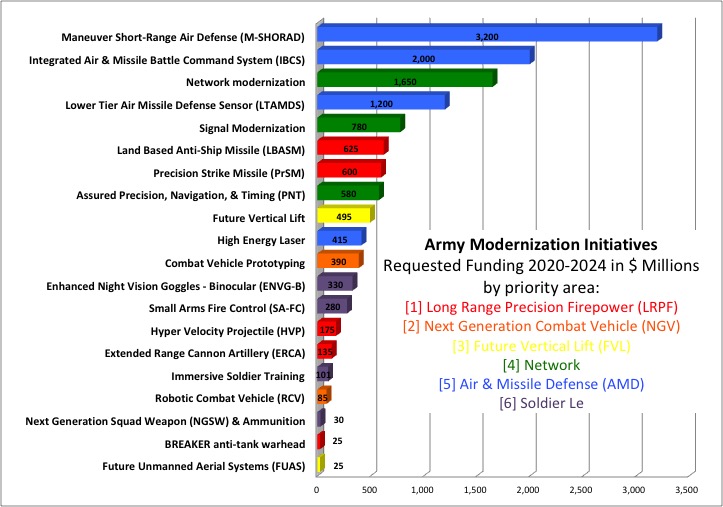
Subscribe to our newsletter
Promotions, new products and sales. Directly to your inbox.
